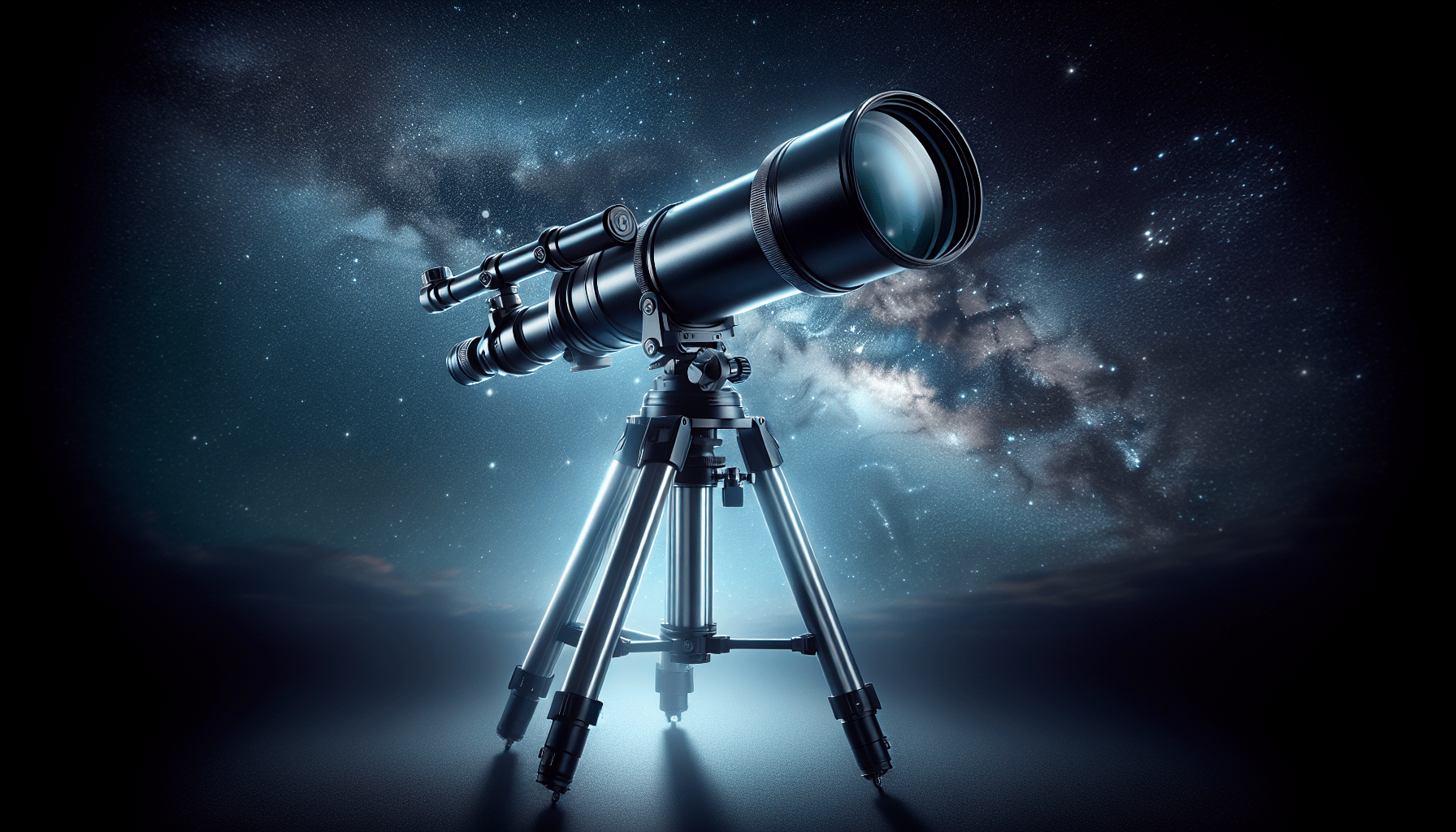Welcome to “A Guide to Different Types of Telescopes,” where your journey through the universe begins with the right equipment. In this friendly and engaging article, you’ll discover the fascinating world of telescopes, from the traditional refractors dating back centuries to modern computerized reflectors that make stargazing almost effortless. Each type has unique features and uses, catering to every level of astronomy enthusiast.
This guide will arm you with the knowledge to choose the perfect telescope for your needs, breaking down complex terms and comparing options to help you make an informed decision. Ready to explore the cosmos? Let’s delve into the stars together! Have you ever found yourself staring at the night sky, mesmerized by the twinkling stars, and wondered how you might get a closer look? Well, you’re in for a treat! Let’s embark on a cosmic journey to explore the different types of telescopes that can bring the mysteries of the universe closer to you.
Table of Contents
A Guide to Different Types of Telescopes

This image is property of images.pexels.com.
Overview
Telescopes are fascinating instruments that allow us to see beyond the confines of our planet and explore celestial wonders. Whether you’re an amateur stargazer or an aspiring astronomer, understanding the various types of telescopes is crucial in choosing the right one for your stargazing adventures.
Thesis Statement
In this guide, you’ll learn about the distinct types of telescopes, their unique features, and which one might best suit your viewing needs. By the end of this article, you’ll have a comprehensive understanding of the different telescopes available, empowering you to make an informed decision.
Historical Context
Telescopes have come a long way since their inception in the early 17th century. Initially, they were rudimentary tools with limited capabilities. Galileo Galilei is often credited with creating the first practical telescope in 1609, which revolutionized our understanding of the cosmos. This early refractor telescope paved the way for advancements that would lead to today’s sophisticated instruments.
Current Trends
In today’s world, technological advancements have made telescopes more accessible and powerful than ever before. Modern telescopes range from affordable models for newbies to high-end equipment used by professional astronomers. Additionally, advancements in digital technology have integrated tools such as computer-guided mounts, which allow for more precise tracking of celestial objects, enhancing the stargazing experience.

This image is property of images.pexels.com.
Key Concepts and Definitions
Before diving into the types of telescopes, it’s important to understand some key terminology:
- Aperture: The diameter of the primary lens or mirror, which collects light. Larger apertures gather more light, making faint objects more visible.
- Focal Length: The distance between the primary lens or mirror and the point where the telescope focuses light. Longer focal lengths provide higher magnification.
- Magnification: The process of enlarging the appearance of an object. It is determined by dividing the focal length of the telescope by the focal length of the eyepiece.
- Mount: The structure that supports the telescope, allowing it to pivot and track celestial objects smoothly.
BREAKING IT DOWN: Types of Telescopes
Refractor Telescopes
Refractor telescopes, also known as dioptric telescopes, use lenses to gather and focus light. They are the progeny of Galileo’s initial design and are renowned for their simplicity and ease of use.
Pros:
- Sharp, high-contrast images: Ideal for observing planets and the moon.
- Low Maintenance: Lenses are typically sealed in tubes, keeping out dust and debris.
Cons:
- Chromatic Aberration: Color distortion that occurs when lenses do not focus all colors to the same point.
- Cost: High-quality refractors can be expensive compared to other types.
For example, the Sky-Watcher EvoStar 100 APO Doublet is a popular refractor telescope that offers exceptional image quality with minimal chromatic aberration, making it a favorite among amateur astronomers.
Reflector Telescopes
Reflector telescopes use mirrors to collect and focus light. The primary mirror reflects light to a focal point, where an eyepiece magnifies the image for viewing.
Pros:
- No Chromatic Aberration: Mirrors reflect all wavelengths equally, resulting in clearer images.
- Cost-Effective: Generally offer larger apertures at a lower cost than refractors.
Cons:
- Maintenance: Mirrors need occasional cleaning and re-alignment (collimation).
- Bulky Design: Large reflectors can be unwieldy and less portable.
A great example is the Orion SkyQuest XT8, an 8-inch Dobsonian reflector telescope that offers excellent light-gathering capacity and is highly regarded for deep-sky observations.
Compound (Catadioptric) Telescopes
Compound telescopes combine lenses and mirrors to correct optical aberrations and utilize benefits from both designs. The two most common types are Schmidt-Cassegrain and Maksutov-Cassegrain.
Pros:
- Versatile: Suitable for both deep-sky and planetary observations.
- Compact: Folded light path results in shorter, more portable tubes.
Cons:
- Cost: More complex designs tend to be more expensive.
- Cool-Down Time: Enclosed mirrors can take longer to reach thermal equilibrium, affecting image quality.
The Celestron NexStar 6SE is a popular Schmidt-Cassegrain telescope known for its compact size, ease of use, and computerized mount, making it a versatile choice for various types of observations.

This image is property of images.pexels.com.
Different Points of View
When evaluating which telescope to choose, it’s helpful to compare and contrast the different perspectives provided by scientists and hobbyists. Experts often prioritize optical quality and mechanical stability, while hobbyists may prioritize ease of use and portability. To illustrate, let’s compare the three types of telescopes in a table:
| Feature | Refractor | Reflector | Compound |
|---|---|---|---|
| Image Quality | High (especially APO) | Excellent | Very Good |
| Maintenance | Low | Moderate (collimation) | Low to Moderate |
| Cost | Higher (per aperture) | Lower (per aperture) | Moderate to High |
| Portability | Portable (smaller models) | Bulky (larger aperture) | Very Portable |
| Viewing Capability | Planets, Moon | Deep-sky objects | Versatile (planetary and deep-sky) |
Impact Assessment
Each telescope type has its own advantages and disadvantages, directly impacting what celestial objects you can observe and how you experience the night sky. For example, those living in urban areas with significant light pollution might gravitate towards refractors for planetary and lunar observation, while rural observers might prefer the light-gathering power of a reflector for deep-sky objects.

Future Directions and Implications
Predictions
As technology continues to advance, we can expect telescopes to become even more user-friendly and powerful. Innovations like adaptive optics, which were once reserved for huge observatories, are gradually making their way into consumer telescopes, offering even sharper images. Additionally, integration with apps and automated star-finding technology will make stargazing more accessible to everyone, regardless of experience level.
Implications
The rise in telescope technology holds significant implications for both professional astronomers and amateurs. Enhanced equipment will enable deeper and more detailed exploration of the cosmos, potentially leading to groundbreaking discoveries. For the general public, more user-friendly telescopes will democratize stargazing, fostering a greater appreciation and understanding of the universe.
Conclusion
To summarize, telescopes are wondrous devices that open up the universe to our curious eyes. Whether you choose a refractor for its sharp images, a reflector for its light-gathering prowess, or a compound telescope for its versatility, each type has its unique charms. With the knowledge gained from this guide, you’re now well-equipped to make an informed decision that will take your stargazing to new heights.
So, next time you find yourself gazing up at the starry sky, remember—you have the tools and knowledge to explore it more closely than ever before. What do you think of the different types of telescopes and which type do you find most exciting?

Engage
To continue your journey into the stars, be sure to check out our other articles on stargazing tips and celestial events. Stay tuned for more insightful content that will keep you well-informed.
Credible Sources
- NASA’s Introduction to Telescopes
- “The History of the Telescope” by Henry King
- Sky & Telescope Magazine
In conclusion, the universe waits for no one, but with the right telescope, you can surely catch up! Happy stargazing!
